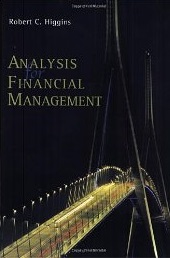We provide finance tutoring for Robert Higgins’s Analysis For Financial Management finance text book.
The Analysis For Financial Management text book by Robert C. Higgins is a wonderful and popular corporate finance text book. I was first introduced to Robert Higgins’s finance book around 2003 or 2004 when looking for a quick recap of corporate finance. I was told that this book was a quick read covering most topics in corporate finance. And it was – Robert C. Higgins’ “Analysis For Financial Management” is truly a great, easy- to- read introduction to corporate finance. I have recommended this book to many students and professionals since then.
When I was first introduced to Robert Higgins’s Analysis For Financial Management finance text book (around 2003 or 2004), it was still in its early editions. It was unlike most corporate text books because it felt like a book or novel that you could read through. Numerous editions of the Analysis For Financial Management book has been published since then making it much larger and heavier and more like a typical corporate finance text book.
Why I love Using Analysis For Financial Management by Robert Higgins to Tutor Finance
Several features make this textbook a great choice for learning corporate finance. First, Robert Higgins’s Analysis For Financial Management finance text book is targeted at non- financial executives and business students without prior knowledge of finance. Because it assumes that the readers do not have prior corporate finance knowledge or experience, it explains the finance concepts in simple easy to understand language with as little finance jargon as possible. (note: a basic understanding of financial statements helps.)
Second, Robert Higgins’s Analysis for Financial Management finance text book does an excellent job of explaining key concepts and tools in a practical, intuitive way. It features numerous real-life examples and comprehensive case studies that illustrate how theory is applied.
Third, Robert Higgins’s Analysis for Financial Management finance text book has an elaborate set of homework exercises for students who decide to put extra effort into mastering the subject. The exercises include case studies and financial models and give students plenty of opportunities to apply what they have learned.
Another thing that makes this book stand out is the author’s apparent passion about financial management. Throughout the book, as a student learns various concepts and tools, it becomes clear how much finance has to say about broader aspects of business management. In addition, the author demonstrates, using many examples, that even the most recent advances in financial theory, such as market signaling, capital asset pricing, agency theory etc., are important for executives and analysts who are involved in making business decisions.
Structure of Finance Topics Analysis For Financial Management by Robert Higgins
As the name of the book suggests, this book does not just explain corporate finance theory, it is focused on the analysis of financial statements to help in decision making. The topics covered in Robert Higgins’s Analysis For Financial Management finance text book include:
Part One: Assessing The Financial Health Of The Firm
- Interpreting Financial Statements
- Evaluating Financial Performance
Part Two: Planning Future Financial Performance
- Financial Forecasting
- Managing Growth
Part Three: Financing Operations
- Financial Instruments and Markets
- The Financing Decision
Part Four: Evaluating Investment Opportunities
- Discounted Cashflow Techniques
- Risk Analysis in Investment Decisions
- Business Valuation and Corporate Restructuring
Other Corporate Finance Textbooks We Tutor
We provide finance tutoring and accounting tutoring for a wide range of textbooks. Some of the corporate finance and investments textbooks we provide finance tutoring for include Ross, Westerfield, Jaffe and Jordan’s corporate finance textbooks which include: Fundamentals of Corporate Finance, Fundamentals of Corporate Finance, Essentials of Corporate Finance and Corporate Finance: Core Principles and Applications, Brealey, Myers, Allen & Edman’s corporate finance textbooks: Principles of Corporate Finance and Fundamentals of Corporate Finance, Eugene F. Brigham and Michael C. Ehrhardt’s finance textbook: Financial Management: Theory & Practice, and Louis C. Gapenski’s Healthcare Finance: An Introduction to Accounting and Financial Management.
Robert C. Higgins, Author, Analysis for Financial Management
Robert C. Higgins (also knows as Rocky) is the Marguerite Reimers Professor of Finance at the University of Washington’s Foster School of Business. He teaches graduate courses in domestic and international financial management. Robert Higgins’ quote on his Foster School of Business web page probably summarizes a central point he tries to make in his text and one we stress while tutoring finance students:
“Unless a company is about to go out of business, its value is in the income stream it generates, and its assets are simply a necessary means to this end. The best possible company would be one that produced income without any assets. Short of this fantasy, financial performance improves as asset turnover rises.”
We state it a little differently from a valuation perspective:
“The value of any asset is the sum of the present values of all its future cash flow.”
Higgins’ quote reminds us that we should add the caveat “unless the company is about to go out of business” when its asset values come into play.
In addition to the University of Washington, Higgins has served on the faculties of Stanford University, IMD Management Development Institute in Lausanne-Switzerland, The Darden Graduate School of Business, The Koblenz Graduate School of Management, and the Gordon Institute of Business Sciences in Johannesburg-South Africa. His research has appeared in the American Economic Review, The Journal of Finance, Financial Management, and Management Science, among others. His current research interests include valuation theory and corporate foreign exchange management. Professor Higgins has a B.S. in Engineering Science and a Ph.D. in Finance from Stanford University and an M.B.A. from Harvard. (Source: McGraw-Hill)
He has also served as Education Director of the Pacific Coast Banking School, Managing Editor of the Journal of Financial and Quantitative Analysis, Academic Director MBA Programs, and Associate Dean for Academic Programs. Professor Higgins has received over three dozen awards for teaching and is a frequent instructor in executive education programs, including those at Microsoft, Stanford, IBM, Boeing, and Bank of America.
Robert C. Higgins has published papers in finance and his current research focuses on foreign exchange exposure for companies.
Email or call us or simply fill out the sign up form below to start live one-on-one finance tutoring using Robert Higgins’s Analysis For Financial Management finance text book or an equivalent finance book.


